warning Citroen C5 2017 (RD/TD) / 2.G Workshop Manual
[x] Cancel search | Manufacturer: CITROEN, Model Year: 2017, Model line: C5, Model: Citroen C5 2017 (RD/TD) / 2.GPages: 348, PDF Size: 10.72 MB
Page 147 of 348
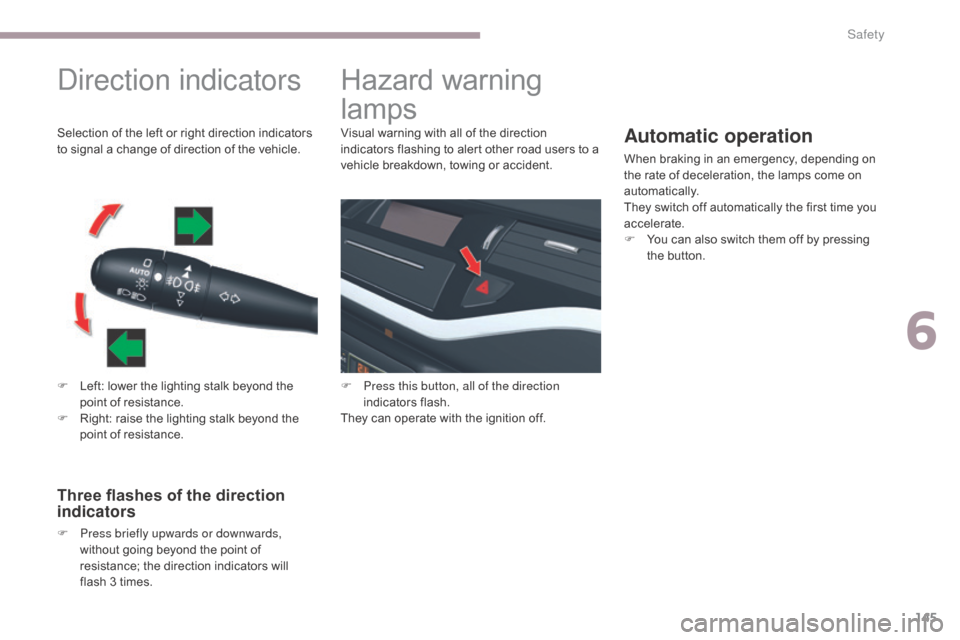
145
C5_en_Chap06_securite_ed01-2016
Direction indicators
F Left: lower the lighting stalk beyond the point of resistance.
F
R
ight: raise the lighting stalk beyond the
point of resistance.
Three flashes of the direction
indicators
F Press briefly upwards or downwards, without going beyond the point of
resistance; the direction indicators will
flash 3 times.
Hazard warning
lamps
Visual warning with all of the direction
indicators flashing to alert other road users to a
vehicle breakdown, towing or accident.Automatic operation
When braking in an emergency, depending on
the rate of deceleration, the lamps come on
automatically.
They switch off automatically the first time you
accelerate.
F
Y
ou can also switch them off by pressing
the button.
Selection of the left or right direction indicators
to signal a change of direction of the vehicle.
F
P
ress this button, all of the direction
indicators flash.
They can operate with the ignition off.
6
Safety
Page 148 of 348
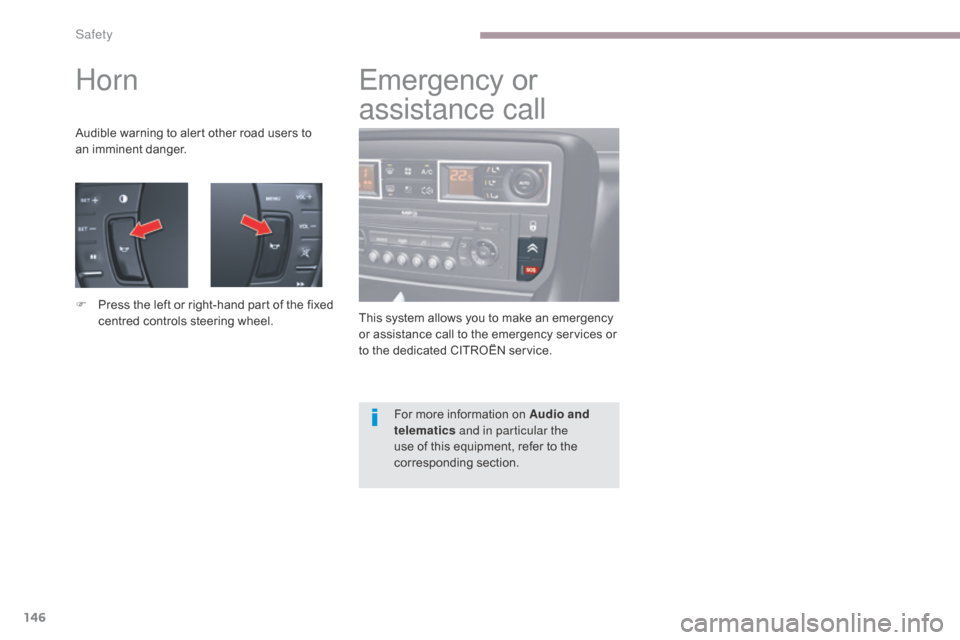
146
C5_en_Chap06_securite_ed01-2016
Horn
Audible warning to alert other road users to
an imminent danger.
F
P
ress the left or right-hand part of the fixed
centred controls steering wheel. This system allows you to make an emergency
or assistance call to the emergency services or
to the dedicated CITROËN service.
Emergency or
assistance call
For more information on Audio and
telematics
and in particular the
use of this equipment, refer to the
corresponding section.
Safety
Page 149 of 348
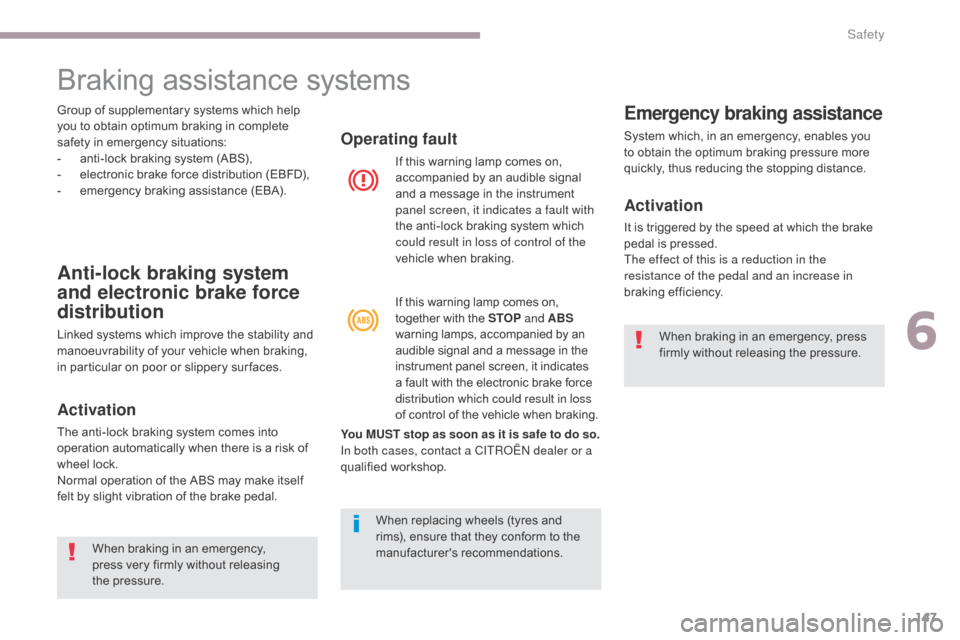
147
C5_en_Chap06_securite_ed01-2016
Braking assistance systems
Anti-lock braking system
and electronic brake force
distribution
Linked systems which improve the stability and
manoeuvrability of your vehicle when braking,
in particular on poor or slippery sur faces.
Activation
The anti-lock braking system comes into
operation automatically when there is a risk of
wheel lock.
Normal operation of the ABS may make itself
felt by slight vibration of the brake pedal.
Operating fault
If this warning lamp comes on,
accompanied by an audible signal
and a message in the instrument
panel screen, it indicates a fault with
the anti-lock braking system which
could result in loss of control of the
vehicle when braking.
If this warning lamp comes on,
together with the STOP and ABS
warning lamps, accompanied by an
audible signal and a message in the
instrument panel screen, it indicates
a fault with the electronic brake force
distribution which could result in loss
of control of the vehicle when braking.
Emergency braking assistance
System which, in an emergency, enables you
to obtain the optimum braking pressure more
quickly, thus reducing the stopping distance.
Activation
It is triggered by the speed at which the brake
pedal is pressed.
The effect of this is a reduction in the
resistance of the pedal and an increase in
braking efficiency.
Group of supplementary systems which help
you to obtain optimum braking in complete
safety in emergency situations:
-
a
nti-lock braking system (ABS),
-
e
lectronic brake force distribution (EBFD),
-
e
mergency braking assistance (EBA).
When replacing wheels (tyres and
rims), ensure that they conform to the
manufacturer's recommendations.When braking in an emergency, press
firmly without releasing the pressure.
When braking in an emergency,
press very firmly without releasing
the
pressure. You MUST stop as soon as it is safe to do so.
In both cases, contact a CITROËN dealer or a
qualified workshop.
6
Safety
Page 150 of 348
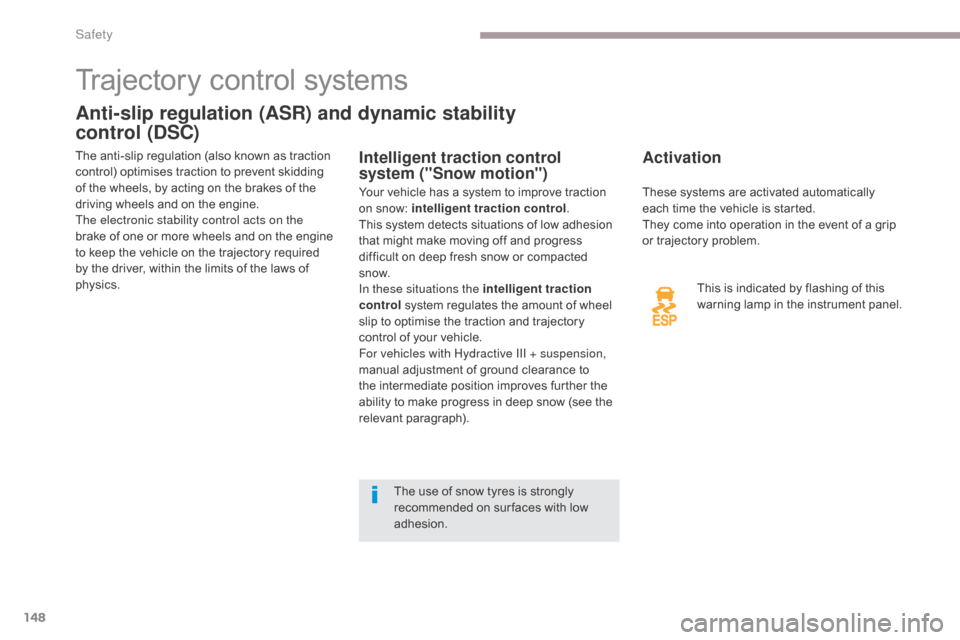
148
C5_en_Chap06_securite_ed01-2016
Trajectory control systems
Anti-slip regulation (ASR) and dynamic stability
control (DSC)
Activation
This is indicated by flashing of this
warning lamp in the instrument panel.
Your vehicle has a system to improve traction
on snow: intelligent traction control
.
This system detects situations of low adhesion
that might make moving off and progress
difficult on deep fresh snow or compacted
snow.
In these situations the intelligent traction
control system regulates the amount of wheel
slip to optimise the traction and trajectory
control of your vehicle.
For vehicles with Hydractive III + suspension,
manual adjustment of ground clearance to
the intermediate position improves further the
ability to make progress in deep snow (see the
relevant paragraph).
The anti-slip regulation (also known as traction
control) optimises traction to prevent skidding
of the wheels, by acting on the brakes of the
driving wheels and on the engine.
The electronic stability control acts on the
brake of one or more wheels and on the engine
to keep the vehicle on the trajectory required
by the driver, within the limits of the laws of
physics.
Intelligent traction control
system ("Snow motion")
These systems are activated automatically
each time the vehicle is started.
They come into operation in the event of a grip
or trajectory problem.
The use of snow tyres is strongly
recommended on sur faces with low
adhesion.
Safety
Page 151 of 348
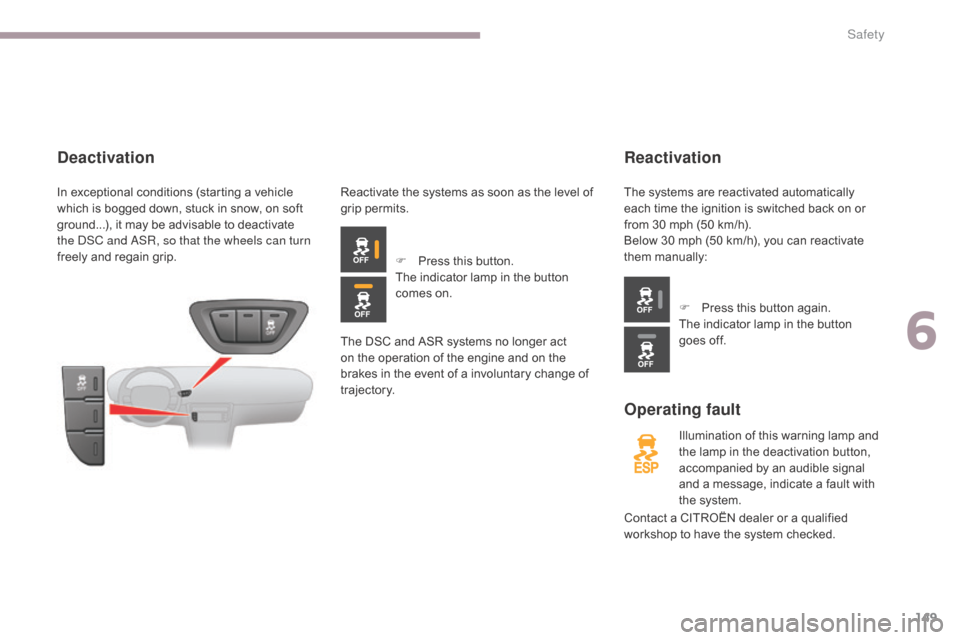
149
C5_en_Chap06_securite_ed01-2016
Reactivation
Operating fault
Illumination of this warning lamp and
the lamp in the deactivation button,
accompanied by an audible signal
and a message, indicate a fault with
the system.
Deactivation
Reactivate the systems as soon as the level of
grip permits.F
P
ress this button.
The indicator lamp in the button
comes on.
Contact a CITROËN dealer or a qualified
workshop to have the system checked.
The DSC and ASR systems no longer act
on the operation of the engine and on the
brakes in the event of a involuntary change of
trajectory.
F
P
ress this button again.
The indicator lamp in the button
goes
off.
The systems are reactivated automatically
each
time the ignition is switched back on or
from 30
mph (50 km/h).
Below 30 mph (50 km/h), you can reactivate
them manually:
In exceptional conditions (starting a vehicle
which is bogged down, stuck in snow, on soft
ground...), it may be advisable to deactivate
the DSC and ASR, so that the wheels can turn
freely and regain grip.
6
Safety
Page 154 of 348
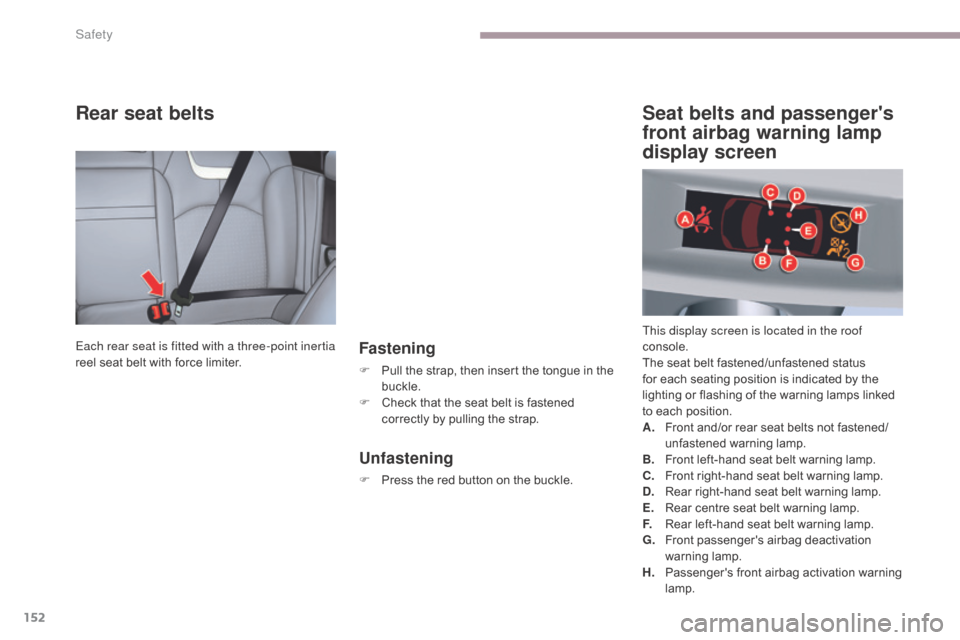
152
C5_en_Chap06_securite_ed01-2016
Rear seat belts
Fastening
F Pull the strap, then insert the tongue in the buckle.
F
C
heck that the seat belt is fastened
correctly by pulling the strap.
Unfastening
F Press the red button on the buckle.
Each rear seat is fitted with a three-point inertia
reel seat belt with force limiter.
This display screen is located in the roof
console.
The seat belt fastened/unfastened status
for each seating position is indicated by the
lighting or flashing of the warning lamps linked
to each position.
A.
F
ront and/or rear seat belts not fastened/
unfastened warning lamp.
B.
F
ront left-hand seat belt warning lamp.
C. F ront right-hand seat belt warning lamp.
D. R ear right-hand seat belt warning lamp.
E.
R
ear centre seat belt warning lamp.
F.
R
ear left-hand seat belt warning lamp.
G.
F
ront passenger's airbag deactivation
warning lamp.
H.
P
assenger's front airbag activation warning
lamp.
Seat belts and passenger's
front airbag warning lamp
display screen
Safety
Page 155 of 348
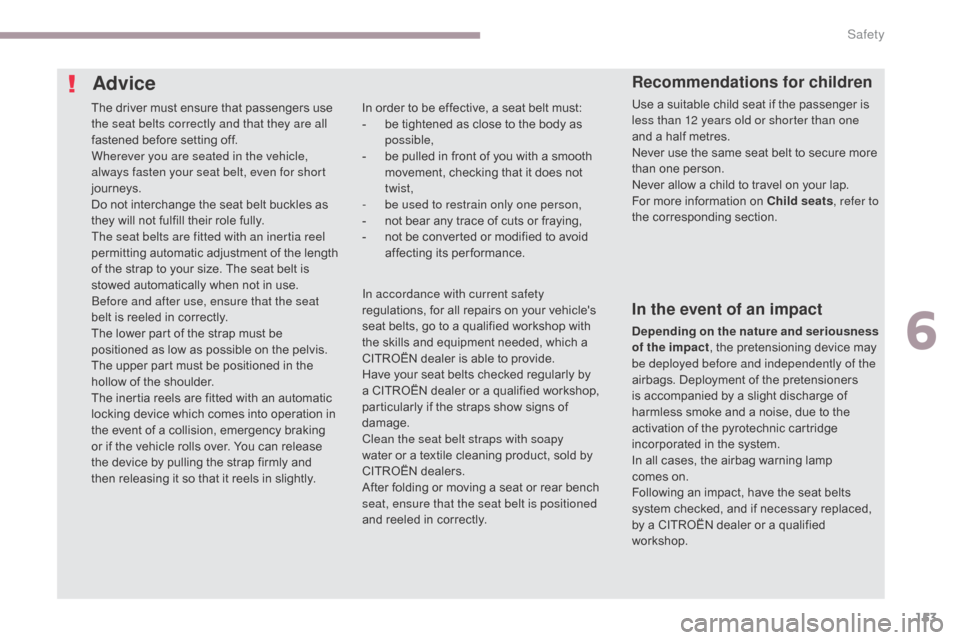
153
C5_en_Chap06_securite_ed01-2016
Advice
In order to be effective, a seat belt must:
- b e tightened as close to the body as
possible,
-
b
e pulled in front of you with a smooth
movement, checking that it does not
twist,
-
b
e used to restrain only one person,
-
n
ot bear any trace of cuts or fraying,
-
n
ot be converted or modified to avoid
affecting its performance.
Recommendations for children
Use a suitable child seat if the passenger is
less than 12 years old or shorter than one
and a half metres.
Never use the same seat belt to secure more
than one person.
Never allow a child to travel on your lap.
For more information on Child seats, refer to
the corresponding section.
In accordance with current safety
regulations, for all repairs on your vehicle's
seat belts, go to a qualified workshop with
the skills and equipment needed, which a
CITROËN dealer is able to provide.
Have your seat belts checked regularly by
a CITROËN dealer or a qualified workshop,
particularly if the straps show signs of
damage.
Clean the seat belt straps with soapy
water or a textile cleaning product, sold by
CITROËN dealers.
After folding or moving a seat or rear bench
seat, ensure that the seat belt is positioned
and reeled in correctly.
In the event of an impact
Depending on the nature and seriousness
of the impact , the pretensioning device may
be deployed before and independently of the
airbags. Deployment of the pretensioners
is accompanied by a slight discharge of
harmless smoke and a noise, due to the
activation of the pyrotechnic cartridge
incorporated in the system.
In all cases, the airbag warning lamp
comes
on.
Following an impact, have the seat belts
system checked, and if necessary replaced,
by a CITROËN dealer or a qualified
workshop.
The driver must ensure that passengers use
the seat belts correctly and that they are all
fastened before setting off.
Wherever you are seated in the vehicle,
always fasten your seat belt, even for short
journeys.
Do not interchange the seat belt buckles as
they will not fulfill their role fully.
The seat belts are fitted with an inertia reel
permitting automatic adjustment of the length
of the strap to your size. The seat belt is
stowed automatically when not in use.
Before and after use, ensure that the seat
belt is reeled in correctly.
The lower part of the strap must be
positioned as low as possible on the pelvis.
The upper part must be positioned in the
hollow of the shoulder.
The inertia reels are fitted with an automatic
locking device which comes into operation in
the event of a collision, emergency braking
or if the vehicle rolls over. You can release
the device by pulling the strap firmly and
then releasing it so that it reels in slightly.
6
Safety
Page 157 of 348
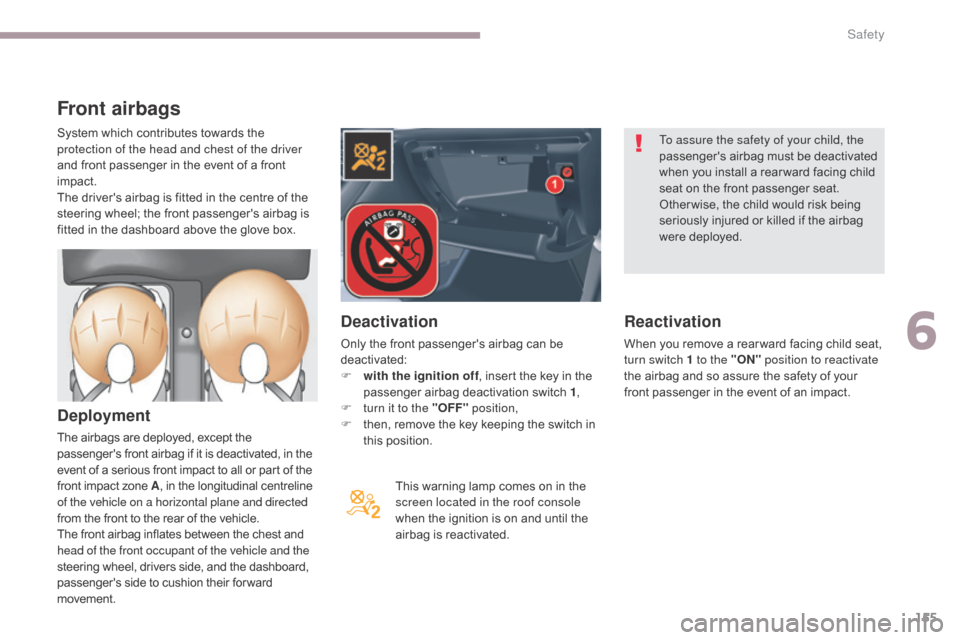
155
C5_en_Chap06_securite_ed01-2016
Front airbags
Deployment
The airbags are deployed, except the
passenger's front airbag if it is deactivated, in the
event of a serious front impact to all or part of the
front impact zone A, in the longitudinal centreline
of the vehicle on a horizontal plane and directed
from the front to the rear of the vehicle.
The front airbag inflates between the chest and
head of the front occupant of the vehicle and the
steering wheel, drivers side, and the dashboard,
passenger's side to cushion their for ward
movement. This warning lamp comes on in the
screen located in the roof console
when the ignition is on and until the
airbag is reactivated.
Deactivation
Only the front passenger's airbag can be
deactivated:
F
w
ith the ignition off , insert the key in the
passenger airbag deactivation switch 1 ,
F
t
urn it to the "OFF" position,
F
t
hen, remove the key keeping the switch in
this position. To assure the safety of your child, the
passenger's airbag must be deactivated
when you install a rear ward facing child
seat on the front passenger seat.
Other wise, the child would risk being
seriously injured or killed if the airbag
were deployed.
Reactivation
When you remove a rear ward facing child seat,
turn switch 1 to the "ON"
position to reactivate
the airbag and so assure the safety of your
front passenger in the event of an impact.
System which contributes towards the
protection of the head and chest of the driver
and front passenger in the event of a front
impact.
The driver's airbag is fitted in the centre of the
steering wheel; the front passenger's airbag is
fitted in the dashboard above the glove box.
6
Safety
Page 158 of 348

156
C5_en_Chap06_securite_ed01-2016
Lateral airbags*
Deployment
It is deployed unilaterally in the event of a
serious side impact applied to all or part of
the side impact zone B, perpendicular to the
longitudinal centreline of the vehicle on a
horizontal plane and directed from the outside
towards the inside of the vehicle.
The lateral airbag inflates between the hip and
shoulder of the front occupant of the vehicle
and the corresponding door trim panel.
Operating faultSystem which contributes towards the
protection of the driver and front passenger in
the event of a serious side impact, in order to
limit the risk of injury to the chest, between the
hip and shoulder.
Each lateral airbag is fitted in the front seat
backrest frame, on the outer side.
If this symbol appears in the
instrument panel screen
,
accompanied by an audible warning
and a message, contact a CITROËN
dealer or a qualified workshop
without
delay to have the system checked. The
airbags may no longer be deployed in
the event of a serious impact.
If the symbol or warning lamp comes on
continuously, do not install a child seat
or an adult on the front passenger seat.
Have it checked by a CITROËN dealer
or a qualified workshop. If this warning lamp flashes, contact
a CITROËN dealer or a qualified
workshop without delay.
* Depending on the country of sale.
Impact detection zones
A. Front impact zone.
B. Side impact zone.
Safety
Page 164 of 348
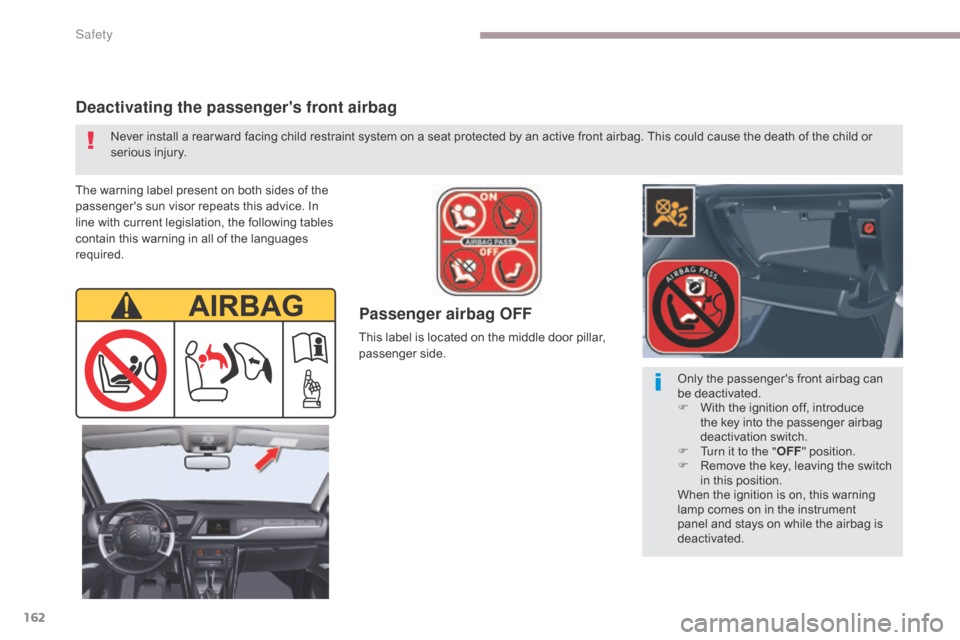
162
C5_en_Chap06_securite_ed01-2016
Passenger airbag OFF
The warning label present on both sides of the
passenger's sun visor repeats this advice. In
line with current legislation, the following tables
contain this warning in all of the languages
required.Never install a rear ward facing child restraint system on a seat protected by an active front airbag. This could cause the death of the child or
serious injury.
Only the passenger's front airbag can
be deactivated.
F
W
ith the ignition off, introduce
the key into the passenger airbag
deactivation switch.
F
T
urn it to the "OFF" position.
F
R
emove the key, leaving the switch
in this position.
When the ignition is on, this warning
lamp comes on in the instrument
panel and stays on while the airbag is
deactivated.
Deactivating the passenger's front airbag
This label is located on the middle door pillar,
passenger side.
Safety